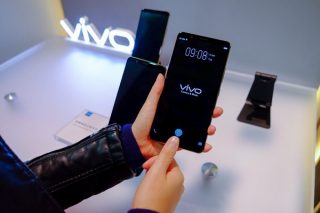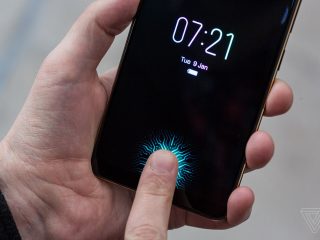What if you could unlock your smartphone simply by placing your finger on the screen at any angle, anywhere and your display acted like a fingerprint sensor? Sounds super-cool, right?
What seemed to be a distant dream two or three years ago, is starting to become a modern reality now.
Smartphone Designs Of The Past
Remember the early 2000s when the phones weighed more than 200 grams and the bezels occupied more space than the screen of the phone? The smartphone designs have gone through a drastic change with time, with the screens getting bigger and the bezels being pushed as far behind as possible.

You don’t have to press and hold the star button to unlock your phone anymore. It’s 2018 and a fingerprint scanner is a modern smartphone necessity. Called the ‘Touch ID’, it has become the standard for every smartphone that comes out in the market nowadays.
Push Towards Bezel-less Designs
But with the screens getting bigger and the phones becoming bezel-less, smartphone designers cannot afford to put the fingerprint scanner on the front. So the Samsungs and the Apples came up with their idea of accommodating the scanner on the back, and the world followed suit.

The Problems Associated With It
Placing the fingerprint scanner on the back of a smartphone is a feasible option, but it isn’t the most convenient of ways to unlock your phone. You need to trace your finger to the scanner and then unlock your phone. If your phone is placed on a flat surface, you cannot unlock it without lifting the phone.
With this in mind, Apple came up with its Face ID technology in the iPhone 10, getting rid of the fingerprint scanner completely. Now that again isn’t the most secure or convenient option of unlocking your phone.
The Solution Is Here
So a solution to this problem was overdue, but nobody expected it to be out in the market so early. The US-based sensor maker, Synaptics came up with its ‘Clear ID’ which, in simple terms, is an optical fingerprint sensor that is placed underneath the display.
Also Read: Here’s How You Can Stop Facebook And Google From Tracking You
Vivo, the Chinese smartphone brand, collaborated with Synaptics to launch the first smartphone, called the Vivo X20 Plus UD, with an in-display fingerprint sensor. In its launch earlier this year, Vivo claimed that the ‘Clear ID’ can unlock the phone in a few milliseconds, even with a screen guard as thick as 1.5 mm.

How does this sensor work?
You have to enroll your fingerprint in the software just like with any physical fingerprint sensor. Now when you’ll take your finger closer to the display, an indicator light will turn on to show where to put your finger. Note that the sensor used here is an ‘optical’ sensor. This means that the display has to be an OLED display as they do not require a backlight, unlike an LCD display. Once you place your finger in the designated area, it lights up the pixels to scan your epidermis and read it.

The process sounds complicated, and it technically is, which is why it’s so rare. But the ease with which the sensor does this job makes it look so obvious.
The Speed Is Impressive
It takes about a second to do the job, which when compared to the usual fingerprint sensors, is slow. But that’s only because the ‘Touch ID’ is ridiculously fast these days and every other unlocking method seems slow in comparison.
The sensor, called the FS9500, is a first-of-its-kind technology and that makes it all the more impressive. If the first generation can be this good, we cannot wait to get a glimpse into the future.
Image Credits: Google Images
Sources: The Verge, Android Authority, Techradar
You’d also like to read:
http://edtimes.in/2018/01/is-it-ever-okay-to-share-passwords-with-your-near-and-dear-ones/







































